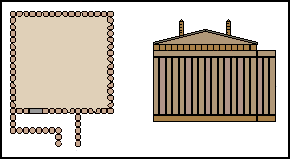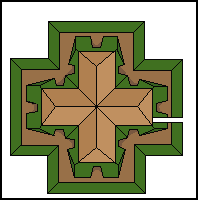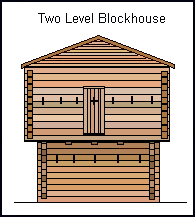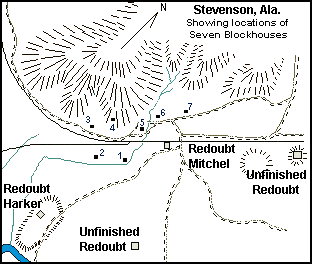Civil War Field Fortifications
Blockhouses
 Blockhouses
were solidly constructed enclosed wooden fortifications designed to allow
small garrisons posted at isolated locations to protect themselves from attacks
by superior enemy forces. They were also used as interior keeps within larger
earthen field works. Like most other minor field fortifications blockhouse
designs ranged through almost all levels of structural complexity from simple
single level squares to large elaborate cross and hexagon shaped works capable
of receiving an artillery armament.
Blockhouses
were solidly constructed enclosed wooden fortifications designed to allow
small garrisons posted at isolated locations to protect themselves from attacks
by superior enemy forces. They were also used as interior keeps within larger
earthen field works. Like most other minor field fortifications blockhouse
designs ranged through almost all levels of structural complexity from simple
single level squares to large elaborate cross and hexagon shaped works capable
of receiving an artillery armament.
However simple or complex, almost all blockhouses were
constructed according to a few commonly accepted conventions that insured
both their structural soundness and usefulness as defensive works.
Blockhouses had to be constructed from material capable of sustaining and
absorbing multiple bullet impacts on their walls and roofs and put together
in a manner designed to maintain their structural integrity under stress
of severe lateral shocks. Logs at least 12 inches thick when squared on either
two or four sides were considered the minimum material necessary for both
walls and roofs to prevent common musket balls from penetrating through to
the interior. The walls could be formed either by placing the logs upright
and side by side in a manner similar to palisadings or they could be laid
horizontally on top of each other and joined with notches in the manner of
a common log cabin. The logs composing
a vertical
wall had to be buried at least three feet into the ground or mortised into
a ground-sill and their tops had to be mortised into a cap-sill, or head
piece, to keep them from spreading and separating.
vertical
wall had to be buried at least three feet into the ground or mortised into
a ground-sill and their tops had to be mortised into a cap-sill, or head
piece, to keep them from spreading and separating.
The minimum height considered necessary for a blockhouse's
wall was nine feet so that troops sheltered in the place could work their
ramrods without excess interference. Twelve feet was considered the
minimum acceptable length for each wall since a shorter wall would not
provide space for enough loop-holes to allow an adequate defense. Due to
the weight of the heavy roof 24 feet was considered the maximum structurally
sustainable length for each wall, any walls 16 feet or longer would require
girder and shore support framing to carry the weight of the roof.
The roofs of most blockhouses had to be constructed to
sustain the same structural shocks as the walls. Most single level blockhouses
were given roofs composed of 12 by 12 logs rabbited at the ends to fit down
snugly onto the cap-sills or topmost horizontal logs of opposite walls. The
resistant roof could be covered by a simple framed top roof to help the building
shed water or it could be covered by at least three feet of soil to help
absorb the initial impact of bullets striking the roof. Vents, chimneys,
or hatches had to be cut through the roof to ventilate the interior spaces
and allow smoke to escape.
Blockhouses with an upper level would, of course,
usually only have light framework on girders to form the ceiling of the lower
level with the resistant roof covering the upper level. The second
level could be constructed to project beyond all four walls of the lower
level or built at an angle to the lowed level with just the four corners
projecting over the central
 sections
of the lower level walls. Those parts of the upper level floor projecting
beyond the lower level would be reinforced and loop-holes cut to allow troops
to fire down on the heads of an enemy attempt to shelter themselves along
the lower level walls.
sections
of the lower level walls. Those parts of the upper level floor projecting
beyond the lower level would be reinforced and loop-holes cut to allow troops
to fire down on the heads of an enemy attempt to shelter themselves along
the lower level walls.
Loop-holes were cut at three foot intervals along each
wall and at least six feet above the ground to prevent an enemy from using
them to fire into the blockhouse. The loop-holes were designed to be wider
on the interior side of the wall to allow muskets to be pointed in all directions
and narrow on the exterior side to maintain as much of the protection afforded
by the walls as possible.
The weakest point on the blockhouse was the doorway and
special precautions had to be taken to prevent direct and unimpeded access
to the door. Some two level blockhouses had the door on the upper level which
was reached by a free standing staircase some four to six feet from the exterior
wall. Loose planks that could be quickly taken up were laid from the staircase
landing to the door way to provide access to the blockhouse. This method
of protecting the door had the great disadvantage of trapping the garrison
inside the work, especially if the staircase was damaged... an unpleasant
situation if the enemy succeeded in setting the blockhouse on fire. A better
method was to construct a narrow re-entering gallery that opened on one end
of the wall and turned to the right or left before it reached the door way.
The exterior gallery wall prevented enemy fire from reaching and weakening
the door while the enemy could only make an attempt on the door in single
file under fire from several loop-holes.

The walls could be further protected by a shallow ditch
dug around the blockhouse with the soil thrown up against the walls. In many
cases the ditch was dispensed with and soil was brought to the site and piled
on the exterior walls almost to the level of the loop-holes to prevent enemy
troops from finding shelter along the walls underneath the loop-holes. But
this arrangement had the very distinct disadvantage of allowing an enemy
easy access to the loop-holes.
Blockhouses were really quite useful little fortifications
that contributed no small measure to the success of Federal field armies
dependent on railroads as their main lines of supply and communications.
Almost as soon as Federal armies entered the Southern and border states
their lines of communication were subjected to attack by guerrillas and other
generally displeased Southern sympathizing citizens. Blockhouses allowed
Federal authorities to maintain hundreds of small garrisons to watch over
isolated, but important, points along hundreds of miles of railroad tracks
that could not have been (at least early in the war) easily or quickly rebuilt.
Although the number of garrisons required a relatively large number of troops,
blockhouses allowed the guards at each point to be reduced to a minimum while
allowing the guards to remain in position in relative safety 24 hours a day.
 The
enclosed nature of blockhouses allowed them to be placed in positions near
the object being guarded without regard to commanding terrain around the
blockhouse. An enemy firing down on the roof of a blockhouse from a distant
hill was bothersome, but hardly dangerous to a garrison holed up in the
blockhouse. Blockhouses were versatile and could be constructed to suit the
needs of any location. An important bridge surrounded by fairly open
country could be well protected by a single large blockhouse; in rugged terrain
two or three small blockhouses could cover the approaches to a bridge both
from the tracks and the slopes of the ravine crossed by the bridge.
In ideals situations blockhouses would be positioned to cover the approaches
to the guarded structure, the structure itself, and other blockhouses or
stockades with fire.
The
enclosed nature of blockhouses allowed them to be placed in positions near
the object being guarded without regard to commanding terrain around the
blockhouse. An enemy firing down on the roof of a blockhouse from a distant
hill was bothersome, but hardly dangerous to a garrison holed up in the
blockhouse. Blockhouses were versatile and could be constructed to suit the
needs of any location. An important bridge surrounded by fairly open
country could be well protected by a single large blockhouse; in rugged terrain
two or three small blockhouses could cover the approaches to a bridge both
from the tracks and the slopes of the ravine crossed by the bridge.
In ideals situations blockhouses would be positioned to cover the approaches
to the guarded structure, the structure itself, and other blockhouses or
stockades with fire.
Though the presence of a blockhouse protected garrison
might intimidate small guerrilla bands and keep them from even attempting
to attack bridges and trestles, they were no match for larger raiding parties,
especially those equipped with artillery. Many engineers seriously believed
that blockhouses could be made to resist artillery fire by giving their walls
a second layer of 12 inch thick logs. But most types of wood tended to lack
the resilience necessary to withstand repeated heavy impacts and none could
break the penetrative power of rifled artillery fire; few blockhouse garrisons
could withstand the threat of artillery and those that did, didn't last long
once the splinters began to fly inside the blockhouse and the walls started
giving way. When the almost inevitable Confederate cavalry raids came roaring
down the railroad tracks, the many blockhouse garrisons were recalled from
their posts and concentrated in larger field works at central points where
they had a better chance of waiting out a raid or repelling an attack.
Back to Minor Works
Rifle Pits
Batteries
Magazines(Restricted
Access)
Contents
Home Page
Major Works
Copyright (c)PEM 1997, 1998
 Blockhouses
were solidly constructed enclosed wooden fortifications designed to allow
small garrisons posted at isolated locations to protect themselves from attacks
by superior enemy forces. They were also used as interior keeps within larger
earthen field works. Like most other minor field fortifications blockhouse
designs ranged through almost all levels of structural complexity from simple
single level squares to large elaborate cross and hexagon shaped works capable
of receiving an artillery armament.
Blockhouses
were solidly constructed enclosed wooden fortifications designed to allow
small garrisons posted at isolated locations to protect themselves from attacks
by superior enemy forces. They were also used as interior keeps within larger
earthen field works. Like most other minor field fortifications blockhouse
designs ranged through almost all levels of structural complexity from simple
single level squares to large elaborate cross and hexagon shaped works capable
of receiving an artillery armament.
 vertical
wall had to be buried at least three feet into the ground or mortised into
a ground-sill and their tops had to be mortised into a cap-sill, or head
piece, to keep them from spreading and separating.
vertical
wall had to be buried at least three feet into the ground or mortised into
a ground-sill and their tops had to be mortised into a cap-sill, or head
piece, to keep them from spreading and separating.
 sections
of the lower level walls. Those parts of the upper level floor projecting
beyond the lower level would be reinforced and loop-holes cut to allow troops
to fire down on the heads of an enemy attempt to shelter themselves along
the lower level walls.
sections
of the lower level walls. Those parts of the upper level floor projecting
beyond the lower level would be reinforced and loop-holes cut to allow troops
to fire down on the heads of an enemy attempt to shelter themselves along
the lower level walls.

 The
enclosed nature of blockhouses allowed them to be placed in positions near
the object being guarded without regard to commanding terrain around the
blockhouse. An enemy firing down on the roof of a blockhouse from a distant
hill was bothersome, but hardly dangerous to a garrison holed up in the
blockhouse. Blockhouses were versatile and could be constructed to suit the
needs of any location. An important bridge surrounded by fairly open
country could be well protected by a single large blockhouse; in rugged terrain
two or three small blockhouses could cover the approaches to a bridge both
from the tracks and the slopes of the ravine crossed by the bridge.
In ideals situations blockhouses would be positioned to cover the approaches
to the guarded structure, the structure itself, and other blockhouses or
stockades with fire.
The
enclosed nature of blockhouses allowed them to be placed in positions near
the object being guarded without regard to commanding terrain around the
blockhouse. An enemy firing down on the roof of a blockhouse from a distant
hill was bothersome, but hardly dangerous to a garrison holed up in the
blockhouse. Blockhouses were versatile and could be constructed to suit the
needs of any location. An important bridge surrounded by fairly open
country could be well protected by a single large blockhouse; in rugged terrain
two or three small blockhouses could cover the approaches to a bridge both
from the tracks and the slopes of the ravine crossed by the bridge.
In ideals situations blockhouses would be positioned to cover the approaches
to the guarded structure, the structure itself, and other blockhouses or
stockades with fire.